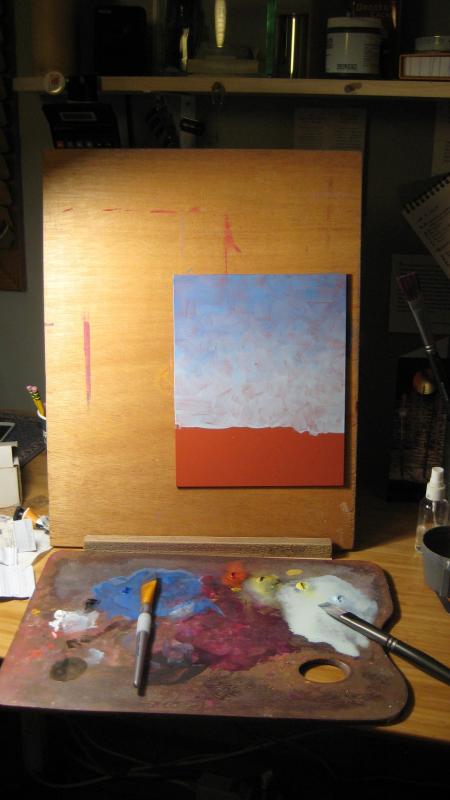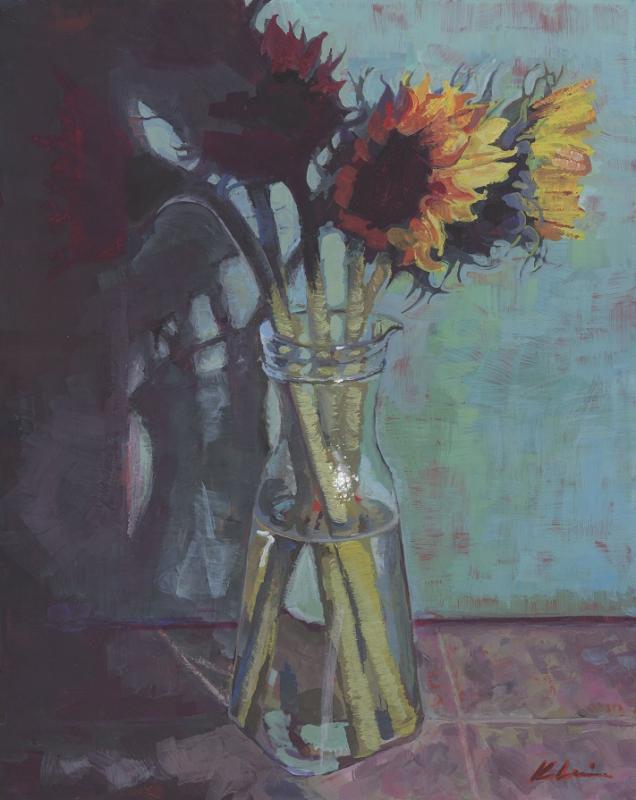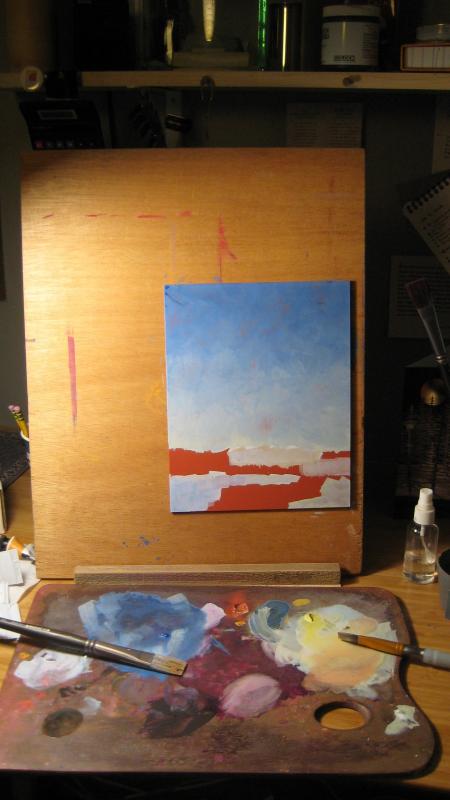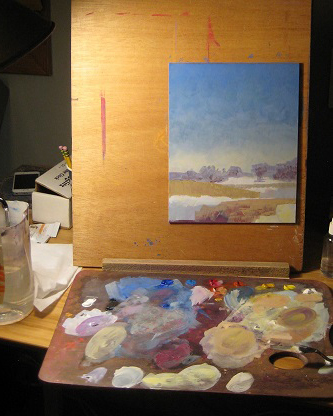Home › Forums › Explore Media › Casein, Gouache, and Egg Tempera › The Creek in Winter – casein
- This topic has 30 replies, 12 voices, and was last updated 6 years ago by
 Donna T.
Donna T.
-
AuthorPosts
-
January 9, 2018 at 1:13 am #449151

The Creek in Winter; casein on Claybord panel; 10″ x 8″
C & C welcome!
P.S. I’ll add some ‘in process’ photos in the comments.
January 9, 2018 at 1:29 am #541865
Since there’s been discussion regarding blending, I took this photo to show how I attempt to create a gradient with casein. What you see is the first layer of sky painted on a toned Claybord panel (toned with 6 coats of Venetian Red casein and allowed to dry for at least 2 weeks), my palette (which at this stage is left over from the previous painting – I’ll recharge it later as this painting develops) and two puddles that I’ve used to create the start of the sky gradient.
It will take four layers to finally achieve the look that satisfies me. That means that the final sky has been painted four times – using eight puddles – four of dark blue and four of pale yellow. For this ‘puddle work’ I often take the panel horizontal and work over the piece – rotating it to randomize the brushwork and to create smoother transitions. With casein, the blending is never perfect and I’ve learned to be content with the nature of the medium – and with the direct way I like to work.
Again, C & C welcome!
– Mary
January 9, 2018 at 8:43 am #541875This is wonderful, but I also like the sky with the ground showing through.
I have some clayboard that I experimented with in terms of casein but put four coats of binder on it and still didn’t like how the paint sat on it and seemed to lift so easily. But I didn’t let it dry for two weeks. Do you have any issues with lifting once you let it dry that long? I have been painting on paper but that means gluing it to a panel when I am done. It would be handy to be able to paint on just panels.
https://www.haroldroth.com/
https://www.instagram.com/haroldrothart
https://www.facebook.com/haroldrothartistJanuary 9, 2018 at 9:54 am #541866Thank you, Harold!
There is some lifting of the Venetian red – even after letting it cure for 2 weeks. But it’s one of the colors on my palette and the lifting is more or less intentional – and certainly anticipated.
Deciding on the best support for casein seems to be a very personal thing. I’ve tried shellacked Baltic birch plywood, Crescent cold pressed watercolor board, watercolor paper, Artefex aluminum composite panel, True Gesso hand made panels and Claybord. There’s balance that needs to be struck between how you like to paint and how you would like the work to be presented. Cost and time come into the equation too. For various reasons, I’ve been settling on toned Claybord. But I may still paint on watercolor board for my plein air work – and then frame that under glass. We’ll see when the weather warms up and I can try one of these Claybord panels outside.
Thanks again for your comment!
– Mary
January 9, 2018 at 10:01 am #541867Here’s another ‘in progress’ photo. I’m still using up left-over paint here. This is after the second layer of sky and the first lay-in of the snow on the ground. You can see, in the upper left, a little bit of wet paint. You need to get used to the value changing as the paint dries – the blue looks very dark when wet but lightens up when it dries.
– Mary
January 9, 2018 at 3:36 pm #541876There’s balance that needs to be struck between how you like to paint and how you would like the work to be presented. Cost and time come into the equation too.
There sure is a balance, and I am not sure I have found it yet. I really like painting on paper. I love how the paint sits on top and is very very opaque because of that. And I have not experienced much lifting with it. I have several paintings now and my next step is to paste them onto a panel. I used a wax to seal them (Dorland’s Wax Medium). It looks fabulous and makes them pretty much waterproof. Learned about this from a watercolorist who treats her paintings this way and then sells them as gallery wrapped over canvases. I sprayed water on a painting and it just beaded up. This was after three coats, letting each coat dry a day, and then polishing before putting on the next coat. Makes a nice sheen. Haven’t tried finishing with shellac yet. Once I get them onto panels, I will give them another wax coating to seal the paper edges and the sides of the panel.
The whole thing about color shift is still freaking me out.
 Today I was finishing something and wanted to mend an area and was horrified when what I added looked stark white. Got out the hair dryer and now it’s invisible. Whew!
Today I was finishing something and wanted to mend an area and was horrified when what I added looked stark white. Got out the hair dryer and now it’s invisible. Whew!Thank you for being such an inspiration.
https://www.haroldroth.com/
https://www.instagram.com/haroldrothart
https://www.facebook.com/haroldrothartistJanuary 10, 2018 at 6:51 am #541856Another fab painting, Mary! And thanks so much for showing your palette and explaining how you blend. I was surprised that your paint is much thinner than I thought it would be.
I think I’m with Harold so far and prefer painting on watercolor paper with casein. I got some claybord panels with an art gift card but didn’t do anything to the one I started painting on as far as adding layers of casein first.
What kind of brushes do you use? I’ve heard synthetic as casein is supposedly hard on brushes but are yours the stiffer or softer kind? So far I’m using synthetic squirrel hair which seems to work but don’t handle as well with casein as they do with gouache. But, I’ve been using the casein thicker than you show.
I know it just takes practice but I really want to master this and appreciate all the help I can get!
January 10, 2018 at 12:59 pm #541868Thanks, Harold and Aba!
The brushes I usually use are Richeson’s Grey Matters and some from a packet I found at Michaels. The Michaels ones were supposed to be for my pochade box but I find they come in handy and are part of the usual mix now. My go-to brushes are my Grey Matters #10s. I’ve got two and have labeled them ‘cool’ and ‘warm’ – and they stay that way until I get absorbed in the work – that is to say, not very long

The thin paint you see isn’t my usual approach – I only do the puddle thing when I’m working on a larger color field or gradient. I’ve attached another ‘in process’ photo (unfortunately, it keeps loading sideways – go figure!) – where I’ve charged the palette and have moved on to the landscape part of the painting.
– Mary
January 10, 2018 at 4:37 pm #541857Hate to be a pest, but I looked up the Grey Matter brushes and there are some for oil, acrylic and watercolor. Are the ones you use for acrylic? What is it that you like about them?
January 10, 2018 at 6:01 pm #541869I’ve been using the Grey Matters series for acrylics for about 5 months now. When I was painting outside, it was nice that they didn’t create major reflections. It’s a little thing but something I appreciate. After 5 months of almost daily use they do show some signs of wear. They’re a bit frayed at the ends – and I’ll probably replace them in a month or two. But for now they’re doing their job. The number 10 flats are actually the least frayed – which seems odd to me because I use them so much. I really like using a big brush (and on an 8″x10″ panel, #10 is big) to do most of the heavy lifting at first. Very first, though, is the #1 round Grey Matters acrylic. That’s what I use for the drawing in Yellow Ochre.
Hope this helps – thanks for asking!
– Mary
January 11, 2018 at 2:33 pm #541863Another great painting and thanks for the explanations. Gary
"Painting is a verb"
January 11, 2018 at 2:41 pm #541858Thanks, Mary, haven’t had time to go back and explore more but hope to soon.
January 11, 2018 at 6:32 pm #541852Nice one Mary.
January 12, 2018 at 6:13 am #541859Quick question – you said you’d painted on aluminum panels. How did you prepare them and did you run into any particular problems with them?
I don’t want to gesso over them as I think one good reason to use the panel is in order to let the aluminum show thru in spots. Is it possible to use the panel as is or will the casein flake off?
January 12, 2018 at 1:11 pm #541870The aluminum panel I used was made by Artefex. It’s called ACM for aluminum composite material. Artefex provides very detailed instructions on how to prepare the panel. I’ll include the link here in case you want to read them: https://www.naturalpigments.com/acm-panel.html
I really like the one painting I did on ACM. But the panels are quite expensive and their lack of porosity slowed me down when I’m so used to casein drying almost instantly. I’m sure I could get used to them but the Claybord is 1/3 the cost and has enough porosity to keep me happy. I really can’t see going back.
You mentioned allowing the aluminum to show through. If you go to the link above, you’ll see that you don’t paint directly on metal. They cover the aluminum with white polyester coli finish which you need to clean and abrade before painting.

Above is the one painting I did on ACM – Door Stop; casein on aluminum; 10″ x 8″
– Mary
-
AuthorPosts
- You must be logged in to reply to this topic.
Register For This Site
A password will be e-mailed to you.
Search

